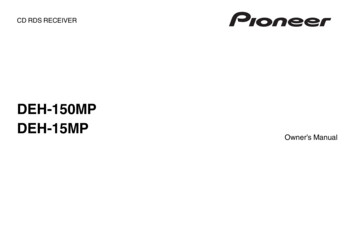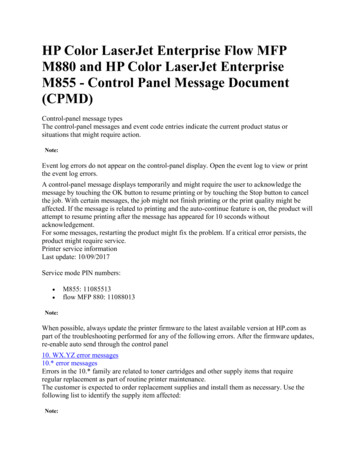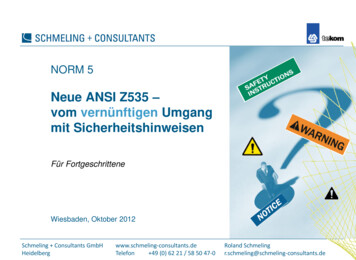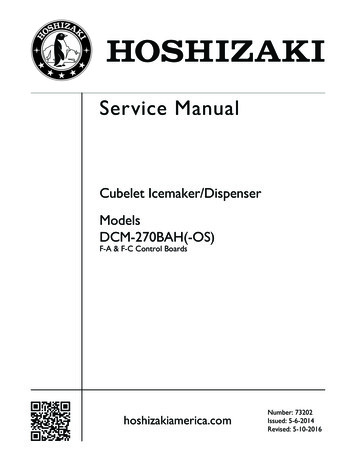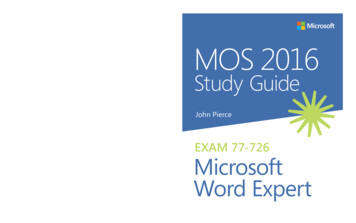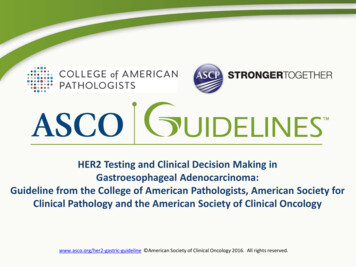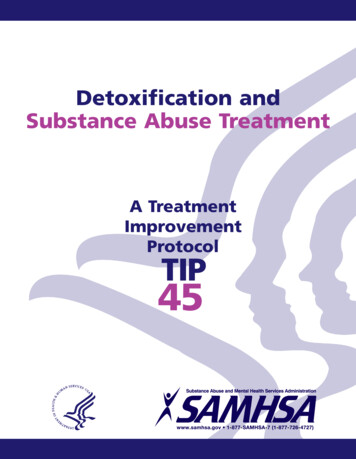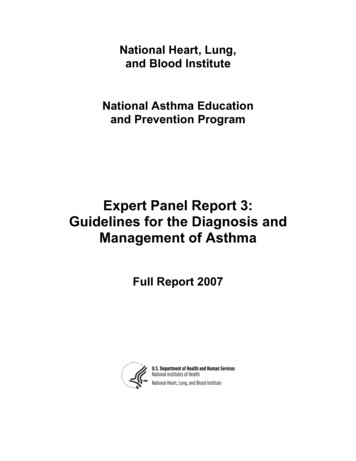
Transcription
National Heart, Lung,and Blood InstituteNational Asthma Educationand Prevention ProgramExpert Panel Report 3:Guidelines for the Diagnosis andManagement of AsthmaFull Report 2007
ContentsAugust 28, 2007CONTENTSAcknowledgements and Financial Disclosures . xiAcronyms and Abbreviations. xixPreface .xxiiSection 1, Introduction .1Overall Methods Used To Develop This Report .2Background.2Systematic Evidence Review Overview.3Inclusion/Exclusion Criteria.3Search Strategies .3Literature Review Process.3Preparation of Evidence Tables.6Ranking the Evidence.7Panel Discussion.8Report Preparation .8References.9Section 2, Definition, Pathophysiology and Pathogenesis of Asthma, and NaturalHistory of Asthma .11Key Points: Definition, Pathophysiology and Pathogenesis of Asthma, and NaturalHistory of Asthma.11Key Differences From 1997 and 2002 Expert Panel Reports .12Introduction .12Definition of Asthma .12Pathophysiology and Pathogenesis of Asthma.14Pathophysiologic Mechanisms in the Development of Airway Inflammation .16Inflammatory Cells.16Inflammatory Mediators .18Immunoglobulin E.19Implications of Inflammation for Therapy .19Pathogenesis .20Host Factors .20Environmental Factors.22Natural History of Asthma .23Natural History of Persistent Asthma .24Children.24Adults .25Summary .27Effect of Interventions on Natural History of Asthma.27Implications of Current Information About Pathophysiology and Pathogenesis,and Natural History for Asthma Management .28References.28i
ContentsAugust 28, 2007Section 3, The Four Components of Asthma Management .35Introduction .35Section 3, Component 1: Measures of Asthma Assessment and Monitoring.36Introduction .36Overview of Assessing and Monitoring Asthma Severity, Control, andResponsiveness in Managing Asthma.36Key Points: Overview of Measures of Asthma Assessment and Monitoring .36Key Differences From 1997 and 2002 Expert Panel Reports .37Diagnosis of Asthma .40Key Points: Diagnosis of Asthma .40Key Differences From 1997 and 2002 Expert Panel Reports .41Medical History.41Physical Examination .42Pulmonary Function Testing (Spirometry).43Differential Diagnosis of Asthma.45Initial Assessment: Characterization of Asthma and Classification of Asthma Severity.47Key Points: Initial Assessment of Asthma .47Key Differences From 1997 and 2002 Expert Panel Reports .48Identify Precipitating Factors .48Identify Comorbid Conditions That May Aggravate Asthma .49Assess the Patient’s Knowledge and Skills for Self-Management.49Classify Asthma Severity .49Assessment of Impairment .50Assessment of Risk .51Periodic Assessment and Monitoring of Asthma Control Essential for AsthmaManagement .52Key Points: Periodic Assessment of Asthma Control.52Key Differences From 1997 and 2002 Expert Panel Reports .54Goals of Therapy: Asthma Control.55Asthma Control.55Measures for Periodic Assessment and Monitoring of Asthma Control .56Monitoring Signs and Symptoms of Asthma .57Monitoring Pulmonary Function .58Spirometry .58Peak Flow Monitoring .59Peak Flow Versus Symptom-Based Monitoring Action Plan .60Monitoring Quality of Life .61Monitoring History of Asthma Exacerbations .63Monitoring Pharmacotherapy for Adherence and Potential Side Effects .63Monitoring Patient–Provider Communication and Patient Satisfaction .63Monitoring Asthma Control With Minimally Invasive Markers andPharmacogenetics.64Pharmacogenetics in Managing Asthma.66Methods for Periodic Assessment and Monitoring of Asthma Control .66Clinician Assessment .67Patient Self-Assessment.67Population-Based Assessment .67Referral to an Asthma Specialist for Consultation or Comanagement .68References .82ii
August 28, 2007ContentsSection 3, Component 2: Education for a Partnership in Asthma Care .93Key Points: Education for a Partnership in Asthma Care.93Key Points: Provider Education .95Key Differences From 1997 and 2002 Expert Panel Reports .95Introduction .96Asthma Self-Management Education at Multiple Points of Care.97Clinic/Office-Based Education .97Adults—Teach Asthma Self-Management Skills To Promote Asthma Control .97Written Asthma Action Plans, Clinician Review, and Self-Monitoring .98Patient–Provider Partnership .99Health Professionals Who Teach Self-Management .100Education With Multiple Sessions .101Children—Teach Asthma Self-Management Skills To Promote Asthma Control . 101Emergency Department/Hospital-Based Education .102Adults .102Emergency Department Asthma Education . 103Hospital-Based Asthma Education.104Children.105Educational Interventions by Pharmacists . 106Educational Interventions in School Settings .107Community-Based Interventions.108Asthma Education .108Home-Based Interventions .109Home-Based Asthma Education for Caregivers.109Home-Based Allergen-Control Interventions.109Other Opportunities for Asthma Education . 111Education for Children Using Computer-Based Technology . 111Education on Tobacco Avoidance for Women Who Are Pregnant and Membersof Households With Infants and Young Children.112Case Management for High-Risk Patients .113Cost-Effectiveness .114Tools for Asthma Self-Management .115Role of Written Asthma Action Plans for Patients Who Have Asthma . 115Role of Peak Flow Monitoring.120Goals of Asthma Self-Management Education and Key Educational Messages . 121Establish and Maintain a Partnership .124Teach Asthma Self-Management .125Jointly Develop Treatment Goals.131Assess and Encourage Adherence to Recommended Therapy . 131Tailor Education to the Needs of the Individual Patient .133Knowledge and Beliefs .133Health Literacy .134Cultural/Ethnic Considerations.135Maintain the Partnership.135Asthma Education Resources .140Provider Education.141Methods of Improving Clinician Behaviors . 141Implementing Guidelines—Recommended Practices . 141Communication Techniques .143Methods of Improving System Supports . 144Clinical Pathways .144Clinical Decision Supports .145References.146iii
ContentsAugust 28, 2007Section 3, Component 3: Control of Environmental Factors and ComorbidConditions That Affect Asthma.165Key Points: Control of Environmental Factors and Comorbid Conditions That AffectAsthma. 165Key Differences From 1997 Expert Panel Report .166Introduction . 167Inhalant Allergens .167Diagnosis—Determine Relevant Inhalant Sensitivity .167Management—Reduce Exposure.169Immunotherapy .172Assessment of Devices That May Modify Indoor Air .174Occupational Exposures .175Irritants .175Environmental Tobacco Smoke .175Indoor/Outdoor Air Pollution and Irritants.176Formaldehyde and Volatile Organic Compounds.176Gas Stoves and Appliances.176Comorbid Conditions.177Allergic Bronchopulmonary Aspergillosis .177Gastroesophageal Reflux Disease .178Obesity .179Obstructive Sleep Apnea .179Rhinitis/Sinusitis .180Stress, Depression, and Psychosocial Factors in Asthma .180Other Factors . 181Medication Sensitivities .181Aspirin .181Beta-Blockers .182Sulfite Sensitivity .182Infections.182Viral Respiratory Infections.182Bacterial Infections .183Influenza Infection .183Female Hormones and Asthma .183Diet.184Primary Prevention of Allergic Sensitization and Asthma .184References.190Section 3, Component 4: Medications.213Key Points: Medications .213Key Differences From 1997 and 2002 Expert Panel Reports .215Introduction . 215Overview of the Medications .216Long-Term Control Medications .216Inhaled Corticosteroids .216Mechanism .216Inhaled Corticosteroid Insensitivity. 217Efficacy of Inhaled Corticosteroids as Compared to Other Long-Term ControlMedications as Monotherapy .217Efficacy of Inhaled Corticosteroid and Adjunctive Therapy (CombinationTherapy) .217Dose-Response and Delivery Device . 218Variability in Response and Adjustable Dose Therapy.219Safety of Inhaled Corticosteroids .220iv
August 28, 2007ContentsKey Points: Safety of Inhaled Corticosteroids .220Key Points: Inhaled Corticosteroids and Linear Growth in Children .222Oral Systemic Corticosteroids .224Cromolyn Sodium and Nedocromil .224Immunomodulators.225Omalizumab .225Antibiotics .226Others .226Leukotriene Modifiers .227Inhaled Long-Acting Beta2 -Agonists .229Safety of Long-Acting Beta2-Agonists . 231Key Points: Safety of Inhaled Long-Acting Beta2-Agonists . 231Methylxanthines .234Tiotropium Bromide .235Quick-Relief Medications .235Anticholinergics .235Inhaled Short-Acting Beta2-Agonists .235Safety of Inhaled Short-Acting Beta2-Agonists .236Key Points: Safety of Inhaled Short-Acting Beta2-Agonists. 236Systemic Corticosteroids .237Route of Administration .238Alternatives to CFC-Propelled MDIs .238Spacers and Valved Holding Chambers . 239Complementary and Alternative Medicine .240Key Points: Complementary and Alternative Medicine .240Acupuncture .240Chiropractic Therapy .241Homeopathy and Herbal Medicine.241Breathing Techniques.241Relaxation Techniques .242Yoga.242References.252Section 4, Managing Asthma Long Term: Overview . 277Key Points: Managing Asthma Long Term .277Key Differences From 1997 and 2002 Expert Panel Reports .278Introduction . 279Section 4, Managing Asthma Long Term in Children 0–4 Years of Age and 5–11Years of Age . 281Diagnosis and Prognosis of Asthma in Children .281Diagnosis of Asthma.281Prognosis of Asthma .281Prevention of Asthma Progression .282Monitoring Asthma Progression.283Treatment: Principles of Stepwise Therapy in Children .284Achieving Control of Asthma .285Selecting Initial Therapy .285Adjusting Therapy.286Maintaining Control of Asthma.288Key Points: Inhaled Corticosteroids in Children .289Key Points: Managing Asthma in Children 0–4 Years of Age .289v
ContentsAugust 28, 2007Treatment: Pharmacologic Issues for Children 0–4 Years of Age. 290FDA Approval .291Delivery Devices.291Treatment: Pharmacologic Steps for Children 0–4 Years of Age. 291Intermittent Asthma .292Step 1 Care, Children 0–4 Years of Age. 292Persistent Asthma .293Step 2 Care, Children 0–4 Years of Age. 293Step 3 Care, Children 0–4 Years of Age. 294Step 4 Care, Children
National Heart, Lung, and Blood Institute . National Asthma Education and Prevention Program
